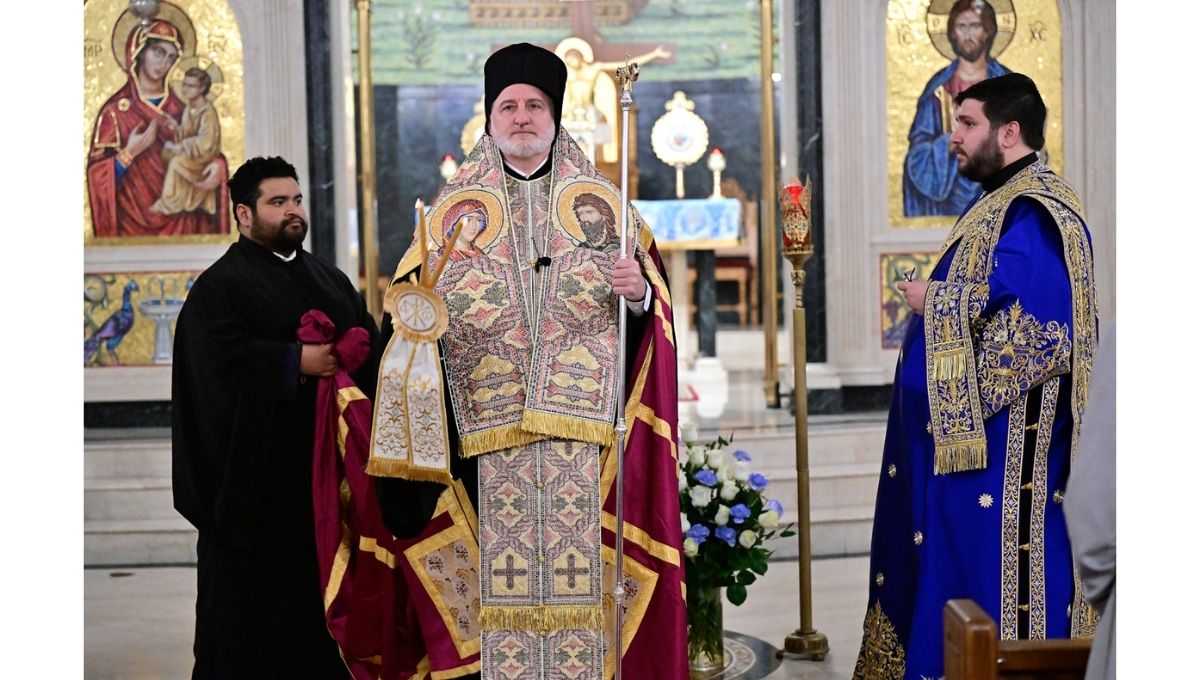His Eminence Archbishop Elpidophoros of America
Homily at the Service of the Akathist Hymn
Saint John the Theologian Greek Orthodox Cathedral
Tenafly, New Jersey
April 8, 2022
Beloved brothers and sisters in Christ,
Tonight, we sing this magnificent canticle of the Akathist Hymn in its entirety and in praise to the Παναγία, our Heavenly Champion.
Tonight, we join with Orthodox Christians across the country and around the world – especially with our fellow brethren in Ukraine, who are relying upon the Virgin to grant them victory over their adversaries. And we join with those pious believers in Russia who are opposing this barbaric invasion, and are praying and working for peace – even despite their own Patriarch and Church leadership. The Hymn is magnificent in its affirmations:
Τῇ ὑπερμάχῷ στρατηγῷ τὰ νικητήρια,
ὡς λυτρωθεῖσα τῶν δεινῶν εὐχαριστήρια,
ἀναγράφω σοι ἡ πόλις σου, Θεοτόκε·
ἀλλ' ὡς ἔχουσα τὸ κράτος ἀπροσμάχητον,
ἐκ παντοίων με κινδύνων ἐλευθέρωσον,
ἵνα κράζω σοί· Χαῖρε Νύμφη ἀνύμφευτε.
To You the Champion, we your City dedicate a feast of victory and of thanksgiving, as ones rescued out of sufferings, O Theotokos.
But as you are one with might that is invincible, from all dangers that can be, deliver us, that we may cry to you: Rejoice, Bride unwedded!
* * *
The Akathist Hymn has been for centuries the spiritual National Anthem of the Greek Orthodox People. It is called “Ἀκάθιστος,” because we stand at attention during its recitation, as once did the People of Constantinople within Hagia Sophia during an attack on the city over one thousand years ago. They remained standing all through the night imploring the Virgin’s mercy upon the Queen of Cities in the Stanzas of this Sacred Ode dedicated to her. And as a result of the victory that came with the dawn, Patriarch Germanos composed “Τῇ Ὑπερμάχῷ” as a song of praise and gratitude to the Most Holy Mother of God.
As you may know, Τῇ Ὑπερμάχῷ was not originally part of the Akathist Hymn, which was composed centuries before by the Deacon and Saint, Romanos the Melodist. The first meaning for the Akathist is easy to ascertain if you pay attention to its content. It is the story of the Incarnation and Nativity of our Lord Jesus Christ, and it was written for the Feast of the Annunciation. This is one of the reasons that it is chanted in the period of Lent, because March 25th almost always falls within the period of the Forty Days.
But the piety and fervor of the People, coupled with the genius of the Akathist, have turned it into something much greater. It has become our anthem of hope, aspiration, and trust in God and His Virgin Mother.
Therefore, my beloved people, let us acknowledge the protective and sustaining role of our Panagia in every aspect of our lives.
She is here to defend us against the assaults of the evil one.
She is here to surround us with her sheltering arms, spread wide in the icons of the Platytera that adorn so many of our Churches; even the Panagia of New York City, who will grace the Saint Nicholas Greek Orthodox Church and National Shrine at the World Trade Center.
She is here to intercede with her Son and God on our behalf:
on behalf of those suffering in this terrible war against Ukraine;
on behalf of children and innocents all around the world;
on behalf of the Church that is the Body of her Son;
and on behalf of each of you, personally and individually.
Because she is a Mother. She is our Mother, whose Son will bind us to His Heavenly Father by the adoption of grace, even as we are bound to His earthly mother through our shared human nature.
And so, through the prayers of our Celestial Champion, the Theotokos and Ever-Virgin Mary, and all the Saints, may we be collectively deemed worthy to attain this divine gift of filial unity.
Amen.
Photos: GOA/D. Panagos

